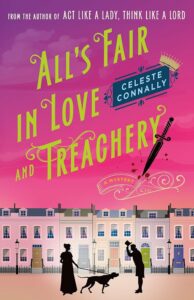Lady Petra Inquires #2
 Celeste Connally introduced the intrepid, fearless, convention defying Lady Petra in last year’s Act Like a Lady, Think Like a Lord. Lady Petra is defying convention purposefully, declaring she will never marry, and since she’s given a house and allowance by her father, she is wealthy enough to do as she pleases. She also has the ear of the Queen. It’s 1815, and London is on the verge of Wellington’s triumph at Waterloo. Queen Charlotte was a force at court thanks to the mental health challenges of King George III. This affects Lady Petra, as the Queen invites her to investigate the mysterious death of the matron at an orphan’s home.
Celeste Connally introduced the intrepid, fearless, convention defying Lady Petra in last year’s Act Like a Lady, Think Like a Lord. Lady Petra is defying convention purposefully, declaring she will never marry, and since she’s given a house and allowance by her father, she is wealthy enough to do as she pleases. She also has the ear of the Queen. It’s 1815, and London is on the verge of Wellington’s triumph at Waterloo. Queen Charlotte was a force at court thanks to the mental health challenges of King George III. This affects Lady Petra, as the Queen invites her to investigate the mysterious death of the matron at an orphan’s home.
The matron had been killed in the chapel while the orphans were in their sleeping quarters for the evening, so Petra is quickly able to narrow her list of suspects. The death seems to be also tied to a threat to the Queen herself, as well as to the whole royal family.
Petra is not a widow, but she is bereaved – her fiancée had died suddenly shortly before their marriage. His death has never been fully explained. Petra has a current romantic partner who was a childhood friend. He also does some undercover work for the royal family, and of course, their investigative threads converge. Things are complicated in this story by the fact that Petra suspects her lover had something to do with her fiancée’s death. I could not believe this for a second, and I was surprised that Petra could, and this is a quibble I had with the book.
Connally paints a wonderfully vivid picture of 1815 London, whose citizens are enjoying the success of Napoleon’s defeat – all of London is a party for a few days. This gives Petra and her paramour cover for their sleuthing, but it also gives cover to the forces that want to take down the royal family. The investigation takes place at night as London is lit up with “transparencies” – window decorations with a lit candle behind them to make them glow.
All of the clues uncovered by Petra and her paramour ultimately tie together, but the history part of the narrative, if you aren’t familiar with the time period, is not always completely clear. The threads are disparate but of course connected, and further connected not only to the death of the matron, but to the death of Petra’s fiancée.
What I loved about the first book was Petra herself. Much like Deanna Raybourn’s Veronica Speedwell, she’s an intrepid woman who has convenient ties to the upper classes (and is herself a member of the “ton”). I hope ladies like Petra and Veronica did indeed exist in their respective time periods. Petra’s band of investigators – who include a lady pharmacist and a fellow socialite who is good with a bow and arrow – add the to richness of the character tapestry in the book.
I felt this was not quite as strong an outing as book one. I certainly enjoyed it, but I felt Petra herself, in all her brave glory, was a tiny bit muted despite some of the shenanigans she gets up to. I certainly look forward to book three, however, and with the resolution of Petra’s fiancée’s death, I am now wondering about her vow to avoid marriage. We shall see, readers. — Robin Agnew